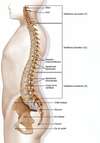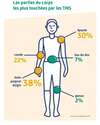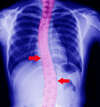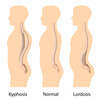06.78.87.39.79
For what?
Pain the first reason for consultation
Pain is a frequent reason for consulting a chiropractor. Chiropractic care can relieve pain in the musculoskeletal system and rheumatic pain. It can be used for acute pain, as well as chronic, recurrent pain.
Spinal pain in the back, joint pain, muscle pain (=myalgia), tendon pain, nerve pain, and also headaches (headache, migraine).
Back pain
Faced with back pain, the chiropractor will be able to find subluxations or blockages in the spinal joints and muscular contractures through examination and palpation of the spine. The chiropractor treats back pain that is characterized by one or more joint blockages, muscle contractures with or without nerve damage. The adjustments, which are the manipulations performed by the chiropractor, make it possible to remove the joint blockages, relax the muscle contractures and free the nerve (or its roots).
- The neck pain is a pain in the cervical spine (neck) like torticollis.
- The dorsalgia is a pain in the thoracic spine
- The low back pain is a pain in the lumbar spine the lower back like lumbago
- The sacralgia is a pain in the sacrum
- the coccygodynia is a pain in the coccyx

Joint pain
- L'osteoarthritis (formerly known as degenerative rheumatism) is characterized by degeneration or wear of joint cartilage. Osteoarthritis progresses more or less rapidly to stiffness and functional discomfort, with a gradual decline in the ability to perform certain everyday tasks.
Chiropractic can help slow down the evolution of arthrosis. Indeed, the chiropractor, through adjustments or mobilization, maintains the movement within the joint.
Some examples of joints most often affected by osteoarthritis
At the level of the spine: the intervertebral joints with the intervertebral disc discarthrosisthe unco-vertebral joints uncarthroseand the posterior interapophyseal joints (zygapophyseal joints).
At the level of the hips coxarthrosisof the knees gonarthrosisof the fingers, the interphalangeal joints, and at the base of the thumb we speak of rhizarthrosis.
- L'arthritis is characterized by the inflammation of the joint.
- L'sprain is characterized by a painful tear or stretch of a ligament.
Nerve pain (neuropathic pain, neurogenic pain)
Nerve pain or neuralgia. Nerve pain is localized at the level of the nerve, the nerve root. It can be projected on the whole nervous territory. The pain is often felt as an electric discharge. It can be associated with paresthesias which are abnormal non painful sensations such as: tingling, tingling, sensation of cardboard skin, numbness. The paresthesias can be the only manifestations of the nerve damage.
- sciatica or sciatic nerve painSciatica is a pain of the sciatic nerve or of one of its roots L5, S1. The pain can be located in the lower back, buttock, thigh, calf, foot and toes. In most cases, sciatica pain is due to a herniated disc that compresses the sciatic nerve at its root.
- cruralgia The crural nerve (also called femoral nerve) or one of its roots is affected. The pain can be localized in the groin and the thigh.
- Cervicobrachial neuralgiaCervicobrachial neuralgia is a condition where a cervical nerve root is affected. The pain can be located in the neck, shoulder, arm, forearm, hand and fingers.
- carpal tunnel syndromeCarpal tunnel syndrome is an injury to the median nerve. It results in paresthesias (tingling, pins and needles, numbness) in the hand and fingers which can also spread to the forearm. By shaking the hand, the patient feels an improvement of his symptoms.
- Arnold's neuralgia or neuralgia of the great occipital nerve, This is an attack on the large occipital nerve. The pain can be localized at the base of the skull, on the head. The patient may also complain of hypersensitivity of the scalp. The headaches are unilateral (on one side of the head).

nb: on the image on the right we can see a herniated disc and a pinched spinal nerve. When the hernia forms at the level of the lumbar discs L4/L5 or L5/S1 we speak of lumbosciatica (sciatica)
Muscle pain (myalgia)
The most common muscular pains we have all experienced, they are fortunately benign and quickly relieved. Among them:
- the muscle cramp
- the muscular aches and pains
- the muscular contracturesThese are referred to by many terms, muscle spasm, trigger point, muscle tension or myogelosis. These are the muscular contractures which, when they persist or are recurrent, very often motivate a consultation with the chiropractor.
Other pains related to injuries or traumas common in the sports world themuscular elongation, the muscle tear or muscle strainthe muscular rupture are also treated in chiropractic.
tendon pain
The tendon can be the site of various injuries. We speak of tendinopathies. For example, there istendon wearwear, the cracking of the tendonthe rupture of the tendon. When a tendon is injured, our body does everything it can to repair the tendon, in particular the inflammatory reaction or inflammation. Tendonitis is the inflammation of the injured tendon. Tendonitis is therefore an injured tendon in the repair phase.
The most common types of tendonitis are :
- the shoulder tendonitis, they concern the muscles of rotator cuff muscles such as tendinitis of the supraspinatus muscle,
- tennis elbow" tendonitis inflammation of the epicondylar tendons ( also called epicondylitis) which are the tendons of the extensor muscles of the wrist and fingers, the "golf elbow or tendinitis in the tendons of the wrist and finger flexor muscles, (also called epitrochleitis )
- at the knee the "windshield wiper syndrome" or inflammation of the tendon of the TFL muscle, patellar tendinitis,
- at the ankle Achilles tendon tendonitis.
Tenosynovitis is the inflammation of a tendon that is surrounded by a sheath. For example tenosynovitis of the long biceps is the inflammation of the tendon of the long biceps muscle in the shoulder, De Quervain's disease is the inflammation of the tendons of the thumb.
A tendon injury can cause pain, limit movement, and create muscle weakness. Chiropractic care is an interesting therapeutic solution.
The care protocol for tendinopathy will include:
- Chiropractic adjustments to all joints,
- treatment of muscular contractures, trigger points
- massage therapy at the tendon level
- the use of ultrasound on the tendon
- recommending exercises that will help restore joint flexibility and muscle balance.
Headaches or headaches
Headaches can be caused by tension in the neck muscles or stress. we talk about tension headaches.
At the neck level joint blockages (subluxations) can also be the cause of headaches we speak of cervicogenic headaches.
At the level of the jaw joint (temporomandibular joint) a dysfunction, a blockage, muscular tensions (in particular in case of bruxism) can also be the cause of headaches. In all these cases, chiropractic is a solution to relieve headaches. In fact, the The chiropractor, by examining the cervical spine (the spinal column at the level of the neck), the temporo-mandibular joint (jaw joint) and the palpation of the muscles, will be able to detect and treat the joint blockages and muscular tensions (or contractures) that are the cause of headaches.
Chiropractic a solution for the care of work-related Musculoskeletal Disorders
MSD or Musculoskeletal Disorders represent in France the first cause of professional disease and can be the cause of permanent disability. Chiropractic can detect, prevent and treat these disorders.
The most common work-related MSDs:
► at the wrist carpal tunnel syndrome
► in the shoulder rotator cuff syndrome
► elbow epicondylitis or tennis elbow
► lower back low back pain
► at the knee the hygroma

Chiropractic for the management of inflammatory rheumatism
In inflammatory rheumatic diseases such as rheumatoid arthritisrheumatoid ankylosing spondylitispsoriatic psoriatic arthritispsoriatic lupus chiropractic can be a complementary or alternative solution to medication.
Chiropractic for the treatment of spinal statics disorders: scoliosis, hypercyphosis, hyperlordosis, curvature inversion.
Scoliosis, the scoliotic attitude
When the spine is not "straight" when viewed from the front and depending on the size of the angle of curvature (or curvatures) we speak of scoliosis orscoliotic attitude.
Even if at the chiropractic examination a scoliosis or scoliotic attitude can be observed, the radiological assessment will allow the diagnosis of scoliosis and will provide specific information for each scoliosis, important for the follow-up.


nb: On this X-ray we can see an "S" shaped scoliosis
Hypercyphosis, senile kyphosis, hyperlordosis
When the curvatures of the spine, seen in profile, are increased, we speak of hypercyphosis in the thorax and hyperlordosis in the lumbar region, and in the latter case you will often be told that you are "too arched".
Hypercyphosis may develop during growth or it may form on an "aging" spine and form a true hump.

Whiplash after a road accident - whiplash
The term Whiplash (was first used in 1928 by Dr. Harold Crowe , an orthopedic surgeon , to describe the movement of the cervical spine in a road accident. Today, the term is used to describe injuries to the cervical spine resulting from a rear- or side-impact road accident, or an accident mimicking this rapid acceleration-deceleration mechanism. Examples include falls, sports accidents and certain merry-go-rounds.
What symptoms should alert you?
- in the cervical region (neck) pain, a feeling of stiffness, muscle tension, loss of mobility, head movements are painful and limited
- headaches headachesoften occipital (at the base of the skull)
- shoulder pain
- in the thoracic region pain between the shoulder blades
- pain and numbness in the shoulder, arm and hand
- pain and/or dysfunction in the jaw (temporomandibular joint)
- a visual impairment
- concentration and/or memory problems
- psychological distress, anxiety, depression, hypochondria
These symptoms result from muscular, ligamentary, nervous, articular lesions, more rarely from a vertebral dislocation, vertebral subluxation, vertebral fracture.

Chiropractic for the management of a posture disorder

Chiropractic is an approach focused on wellness and prevention!

Chiropractic care is particularly recommended for people who want to :
► take action to improve their well-being
► prevent the development of health problems related to malfunctioning of the spine or other joints.
► slow down the ageing process and maintain optimal mobility in the spine and joints of the body.
► a health advisor.
Other reasons for consultation:
► stress, insomnia
► gait disorder, flat foot
► dizziness
► disorders of the temporomandibular joint (the jaw) blockages, pain, bruxism